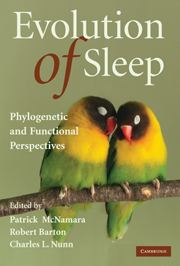Book contents
- Frontmatter
- Contents
- Contributors
- Acknowledgments
- Introduction
- 1 Ecological constraints on mammalian sleep architecture
- 2 Sleep in insects
- 3 Schooling by continuously active fishes: Clues to sleep's ultimate function
- 4 What exactly is it that sleeps? The evolution, regulation, and organization of an emergent network property
- 5 Evolutionary medicine of sleep disorders: Toward a science of sleep duration
- 6 Primate sleep in phylogenetic perspective
- 7 A bird's-eye view of the function of sleep
- 8 The evolution of wakefulness: From reptiles to mammals
- 9 The evolution of REM sleep
- 10 Toward an understanding of the function of sleep: New insights from mouse genetics
- 11 Fishing for sleep
- Index
- Plate section
- References
10 - Toward an understanding of the function of sleep: New insights from mouse genetics
Published online by Cambridge University Press: 10 March 2010
- Frontmatter
- Contents
- Contributors
- Acknowledgments
- Introduction
- 1 Ecological constraints on mammalian sleep architecture
- 2 Sleep in insects
- 3 Schooling by continuously active fishes: Clues to sleep's ultimate function
- 4 What exactly is it that sleeps? The evolution, regulation, and organization of an emergent network property
- 5 Evolutionary medicine of sleep disorders: Toward a science of sleep duration
- 6 Primate sleep in phylogenetic perspective
- 7 A bird's-eye view of the function of sleep
- 8 The evolution of wakefulness: From reptiles to mammals
- 9 The evolution of REM sleep
- 10 Toward an understanding of the function of sleep: New insights from mouse genetics
- 11 Fishing for sleep
- Index
- Plate section
- References
Summary
Whether all species sleep or meet the common definition of sleep has recently been questioned (Siegel, 2008). In the majority of species that do sleep, however, the evolutionary conservation of DNA elements regulating sleep and its features highlights the physiological importance of this behavior. From an “adaptation” point of view, we would like to think of sleep as solving a problem, just as we do for traits such as eating, drinking, and so on. In such a perspective, the perpetuation of particular sleep genes would have occurred through improved fitness of the individuals with those genes. Clear scientific evidence on this matter, however, is still missing. Historically, the science of sleep has evolved from a key technological innovation: the development of electrophysiological instruments that allow the recording of changes in electrical activity in brain and muscles. Such a phenomenological approach has been successful in providing a practical framework for understanding “how” we sleep, but it has not contributed to solving the question of “why” we sleep.
The year 1953 was an important year for two important research fields: sleep and genetics. The discovery of rapid-eye-movement (REM) sleep at the University of Chicago, announced in Science (Aserinsky & Kleitman, 1953), laid the foundation for modern research on sleep. That same year, from the Cavendish laboratory in Cambridge, UK, Crick and Watson sent their proposal of a structural model of DNA to Nature (Watson & Crick, 1953b).
Information
- Type
- Chapter
- Information
- Evolution of SleepPhylogenetic and Functional Perspectives, pp. 218 - 237Publisher: Cambridge University PressPrint publication year: 2009
References
Accessibility standard: Unknown
- 1
- Cited by
